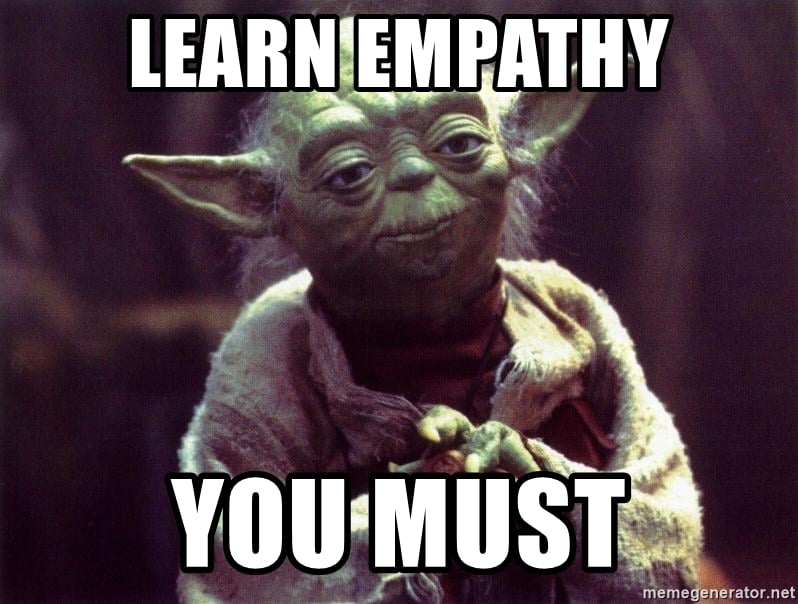Let’s be blunt: without customer-centric principles, a business is doomed to be soulless. But by adopting philosophies that keep the customer in mind at all times, companies can create a product that impress users.
What does it mean to be customer-centric? In a nutshell, you’re prioritizing your customers as the ultimte stakeholder. This isn’t just the job of a Product Manager or Customer Success team. Customer-centric principles should be adopted across an entire organization, from Marketing and Sales to Engineering and Design.
Why? Because customer-centric principles are the key to creating a positive user experience. Only when you understand your users’ needs, wants, and pain points, can you work to address them. And make no mistake – the customer will feel the pedestal placed beneath them.
They will respect your brand, and you’ll stand out among those of your competitors who are more product-centric, or who simply ‘guess’ what the user might want.
Adopting customer-centric values often relies on being able to perform extensive user feedback. UX testing and user interviews helps you gain data to inform decision making. These insights can help strengthen your strategy around not just the product, but customer support and branding.
Here are 14 customer-centric principles to help you take your business to the next level.
14 Key Customer-Centric Principles
1. Empathy
One of the most obvious customer-centric principles is that of empathy. How can you ever truly see things from your customer’s perspective if you can’t empathize with them? Well, young Padawan, to put it simply: you can’t.

By empathy, we mean to understand your customers’ needs, pain points, and motivations, as much as you possibly can, and then elevate their voices throughout your company. User research too often sits in a silo, unacted upon. Flip things around: every single person in your organization should know and understand your users. Whether you’re in Sales and Marketing or Engineering and Design, it makes no difference.
To help achieve this, you’ll need to find a way to document user research in an accurate and accessible way. Browse through our list of UX research repositories to find one that will be easily accessible for your entire team. You can even convert well-known and frequently used softwares like Notion into research repositories.
To fully understand the needs of your customers, you need to be recording and transcribing your user interviews. With tl;dv, the industry-leading remote UX research tool, this is easier than breathing. In fact, you just invite tl;dv’s AI to the chat and it will do it all for you, including generating summaries at the end of each call. With its meetings library and powerful AI-powered search function, tl;dv works as a standalone research repository for user interviews too.
The most important thing with tl;dv is that it’s remarkably easy to cut, clip, and share specific moments from the meeting with anybody in your team. You can set timestamps mid-call and then copy and paste a hyperlink to your work repository of choice, and voila! Stakeholders can catch up on your customers’ wants and needs in their own voice in just a couple of minutes.
Customer empathy can also be fostered with other tools such as UserTesting, Hotjar, and Qualtrics.
2. Keep Bias at Bay
While bias is impossible to completely carve out, it’s definitely something you can bring more attention to. If you have a bias embedded in your company, it can interfere with point one: empathy. Bias is like a blurry lens over reality. It makes you think everything is normal, but you’re missing the finer details: what the customers actually want.
The only thing you should expect is the unexpected. Enter user research prepared to be surprised and you’ll learn a lot more than if you go in with preconceived ideas. The problem is most preconceived ideas are subconscious.
There are various tools you can use to help you reduce bias. IBM’s Watson is a great AI tool for identifying bias in your research. Product managers can also make use of ChatGPT to a similar effect.
Another way to nip preconceptions in the bud before they sprawl out and infect every aspect of your business: the Mom Test. When conducting user interviews, keep the Mom Test in mind and you’ll get far more insights.
3. User-Centered Design
At the risk of sounding even more obvious than the first point, user-centered design can only be crafted through constant and continuous user tests. As a customer-centric principle, you have to keep the user in mind at all times. A half-baked job just isn’t going to cut it. Customers will see through it like glass.
See our other article for the ultimate tips on customer-centric product development. To put it briefly, keep the user’s experience in mind the entire time you’re creating the product. Product managers should use it as a reference point during weekly reviews and other product development meetings.
While tl;dv can also be used to maintain a connection between the design team and the product team, there are other tools that are more important for this customer-centric philosophy.
Figma, Sketch, and Adobe XD can all help teams create user-centered designs and prototypes, while usability testing tools like UserTesting, Hotjar, and Maze can help teams test and validate their designs with real users.
4. Customer Feedback
We’ve sort of covered this a little bit in each of the above points, but strong customer feedback deserves to have its own place in this list of customer-centric principles. It’s too important to miss out.
You’ll want to gather feedback from customers regularly to understand how they’re using your product. What do they like or dislike about it? If you don’t already know, it’s time to find out!
With customer feedback in hand, a product manager can make important decisions that improve your product in multiple ways. There are no limits to the ways in which you can collect customer feedback either:
- Offer the user a quick survey if they uninstall a product or deactivate their paid plan
- Ask users to quickly rate new features with a score
- User interviews where you ask a broad range of users specific questions in preparation for new features or products
<
The art of great customer feedback lies in your ability to continuously gather it. It needs to be a continuous stream, otherwise you’ll lose touch with your target audience and drift apart. With a constant supply, you’ll have ample ways to improve your product or service, with the knowledge that this is what your users actually want, and not just what you think they want.
There are dozens of great tools out there for harvesting customer feedback. SurveyMonkey, Typeform, Google Forms, and Zendesk can all help teams collect and organize feedback from customers.
5. Agile Development
An agile development methodology allows you to iterate quickly and respond to customer feedback in real-time. This is one of the most important customer centricity principles to implement because they help teams work in a flexible and collaborative manner to deliver high-quality products on a consistent basis.
If you’re looking to build out a customer-centric product team, these are some ways that agile development can help:
- Rapid Integration. Agile frameworks prioritize flexibility and speedy iteration. Teams can make swift decisions based on user feedback and make product changes on-the-go, ensuring that they never lose touch with the standards of their customers.
- Cross-functional Teams. Cross-functional teams tend to emerge from agile frameworks. Members from different sectors collaborate to deliver the product and this helps to make certain that the customer’s needs are considered and met at every stage of the product development process.
- Customer Collaboration. Agile frameworks allow for close collaboration with the user. By providing regular feedback, product teams can ensure that the product is meeting their needs. This is the best way to create a product that truly resonates with the customer and addresses their pain points in an almost personal manner.
- Prioritization. As we’ve already established, the customer’s needs are the most important thing. Agile frameworks help teams prioritize their work to meet and solve customer needs. Product teams can choose the most important features and improvements based on the customer’s needs, making sure that they’re delivering the most value possible to the customer.
- Transparent Communication. Agile frameworks encourage transparent communication and regular check-ins with everybody in your organization. This ensures that everyone is on the same page and working towards a common goal. Alignment like this will help to build trust and nurture a positive relationship with the customer.
By being agile in your product development, you can stay in touch with the customer and make sure you’re building something that they’ll truly love. Using project management tools like Jira, Trello, and Asana or similar alteranatives can help teams adopt agile methodologies and implement rapid iterations.
6. Collaboration
Another crucial customer-centric principle is collaboration. You can’t make a quality customer-centric product without good teamwork. By bridging the gap between different development teams and stakeholders, you can align the goals, vision, and hurdles to overcome throughout your entire business.
Communication and collaboration tools like Slack, Google Meet, and Zoom can help teams communicate and collaborate in real-time, regardless of their location. And with tl;dv, you can further increase collaboration by including teams of an async nature. If somebody can’t attend a meeting for whatever reason, be it they’re asleep on the other side of the world, or they’re simply sick, tl;dv will let anybody and everybody catch up on the meeting in mere moments.
tl;dv works with both Zoom and Google Meet, and you can instantly share clips, highlights, or timestamps from a meeting directly onto Slack or any other work messenger. Gone are the days where meeting attendance was important. We’re in a new era now; one where teams with workers from around the globe can all align their goals and collaborate remotely to build a product that they can be proud of.
7. Data-Driven Decision Making
What good is user research if you’re not going to use the data gathered? The entire point of user research is to create a new view of how your customer sees the world, and more importantly, your product. How can it help them, what do they use it for, what do they need from it, and how can you make that a reality?
By collecting and storing user research data in an easily accessible repository, you create a single source of truth for your entire organization to dip into. A strategy decision should never be based on a ‘hunch’ or presumption. Your product team should always be able to point toward research and data-derived insights as the reason the product is being developed or led in a particular way.
There are dozens of tools that can help with this, including the aforementioned tl;dv. Nothing beats having the customer’s own voice telling you what they want, and their facial expressions and mannerisms revealing the emotion behind their words.
Other analytics and data visualization tools like Tableau, Google Analytics, and Mixpanel can help teams collect and analyze data to inform decision making, too.
8. Never Stop Innovating

It’s easy to slip into the comfort zone, doing the same thing over and over again. But what works today might not work tomorrow. You have to keep an open mind and be ready to challenge existing frameworks, strategies and principles. This is the key to keeping your product competitive.
Everybody talks about innovation as if it’s a thing of magic, clutching at smoke with their bare hands to try and nab themselves a piece. In reality, you can innovate by keeping your ears open. Listen to your customers and they will tell you exactly how to innovate.
There are several tools designed to help teams manage the entire innovation process, from ideation to execution. If this sounds like something you’d be interested in, IdeaScale, Brightidea, and Spigit come to mind.
9. Foster a Culture of Sharing Knowledge and Ideas
Encourage everyone in your business to contribute their ideas, no matter how wild and spicy they may be. Just as the most outlandish myths and legends spring from a nugget of truth, the craziest and most controversial ideas have a nugget of genius. It’s your job to mine the nuggets.
If a company culture truly welcomes new ideas, innovation has to follow. It’s some kind of universal law. The creative energies bouncing back and forth act as a kind of pressure that will eventually catapult your product to the next level. Imagine you’re all sat on a geothermal fissure, but it fires creative juices and success rather than scorching hot water.
Okay, that wasn’t the best analogy, but by creating a healthy culture of sharing, you’ll build an environment in which innovation can flourish. Use your everyday collaboration tools to keep track of these ideas: Trello, Asana, and Notion all work well.
10. Automate and Scale
The world has come a long way when AI gets a nod for being an important customer-centric principle. But here we are, with tools that can complete tasks five times quicker than us measly humans can.
@tldv.io Written by ChatGPT #inception #chatgpt #ai #openai #meeting #corporate
♬ original sound - tldv.io - AI Meeting Recorder
Product teams in particular should be making the most of modern technology to speed up and simplify their often lengthy and complex tasks. More productivity is a good thing more often than not, especially in the product development world.
Tools like HubSpot, Pardot, and Marketo can help teams automate marketing, sales, and customer service activities, while software like Zapier can help automate workflows between different applications.
We’re also in the right time period to witness the rise of the AI meeting assistant. Even your virtual meetings can get shortened and simplified with a tool like tl;dv.
11. Personalization
One of the crucial customer centricity principles is that of personalization. Can you think of a better user experience than one that is tailored to a specific user? Personalized experiences cater to each customer’s specific needs and preferences. If you can incorporate this into your business, you’re sure to win over your customers for good.
The downside to personalization is user privacy. Not everyone wants a tailored experience if it means their user data is being used against them. Keep this in mind when thinking of personalizing your user’s experience with your product.
Segment, Tealium, and Lytics are customer data platforms that help your team collect and unify customer data, while personalization platforms like Optimizely, Dynamic Yield, and Evergage can help teams create and deliver personalized experiences to customers.
12. Transparency
There’s no better way to win over your customers’ hearts than by being completely transparent with them, especially if you’re opting for the personalized experience outlined above. Let users know exactly what you’re doing with their data, how you’re storing it, and how they can opt out.
It’s also important to provide clear and accurate information about any other service you offer, including what’s included in any subscriptions (and what’s not), or any potential issues or problems that users may encounter with your product. Put the customer first and respect their privacy.
Tools like Intercom, Help Scout, and Freshdesk can help teams provide clear and accurate information to customers through email, live chat, and other channels.
13. Responsiveness
Always try to be responsive to your customers’ needs and concerns. Speak to them on a personal level and make an effort to address any issues quickly and effectively.
A good customer support team can help here, but they should have continuous contact with the product team. Set up great communication channels so that a product manager can understand the pain points of the user far more effectively. In fact, it’s a good idea for product managers to help out with customer support tickets occasionally to really feel their pain. Likewise, customer support can understand what the product team is doing to fix it so that they can update their responses and let the customer know that their issue is being worked on.
Zendesk, Freshdesk, and Help Scout are great customer service and support tools that can help teams respond to customer inquiries and issues in a timely and efficient manner.
14. Customer Advocacy
One of the most important but least talked about customer-centric principles is customer advocacy. This is all about standing up for your customers, even if it involves putting them, and decisions that benefit them, ahead of decisions that are more convenient or profitable.
Obviously, nobody expects you to put yourself out of business by being so customer-friendly, but a business that goes to infinity and beyond to have their customer’s back is one that they will remember forever. And tell all their friends about…

To achieve the same kind of loyalty that Woody and Buzz have to Andy, you have a few software options. UserVoice and Delighted, in particular, can help teams measure customer satisfaction and advocate for their needs. A meeting recorder like tl;dv, meanwhile, can help feed video-based user insights into platforms like Slack, Hubspot, Notion, Confluence. These insights are rich with emotion and easy to share, allowing the customer voice to become ubiquitous across an entire organization. The result? A roadmap and strategy that’s truly customer-centric.





